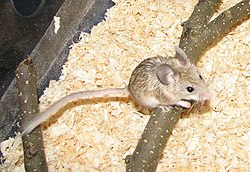| Mouse-like hamster Temporal range: | |
|---|---|
 | |
| Scientific classification | |
| Kingdom: | Animalia |
| Phylum: | Chordata |
| Class: | Mammalia |
| Order: | Rodentia |
| Superfamily: | Muroidea |
| Family: | Calomyscidae Vorontsov & Potapova, 1979 |
| Genus: | Calomyscus Thomas, 1905 |
| Type species | |
| Calomyscus bailwardi Thomas, 1905 | |
| Species | |
Calomyscus bailwardi Contents | |
Mouse-like hamsters, also called brush-tailed mice or calomyscids, are a group of small rodents belonging to the genus Calomyscus found in Syria, Azerbaijan, Iran, Turkmenistan, Afghanistan, and Pakistan. They are found in rocky outcrops and semi-mountainous areas in desert regions. The generic name Calomyscus derives from the Greek word kalos, meaning 'beautiful'; the full name translates to "beautiful mouse". [1]
The mouse-like hamsters are not true hamsters, but represent an early split from the rest of the mouse-like rodents. They were once thought to be hamsters based on the shape of their molars, but they lack the cheek pouches, flank glands and short tails of the true hamsters. The closest relatives of the mouse-like hamsters may be the extinct Cricetodontidae. [2] Because of their seemingly early break from the rest of the mouse-like rodents, mouse-like hamsters have been placed in a family of their own, Calomyscidae, and have been referred to as living fossils. [1] [3]
All members of the genus were once considered part of the same species, Calomyscus bailwardi , but they are now considered separate species due to major differences in chromosome number, skull measurements, and other features. [4] Several species have been discovered in the 2020s, [5] including Behzad's brush-tailed mouse (C. behzadi) [6] and the Kerman brush-tailed mouse (C. kermanensis). [7] There are two known extinct species: C. delicatusAguilar et al. 1984 and C. minorde Bruijn et al. 1970. [8]








